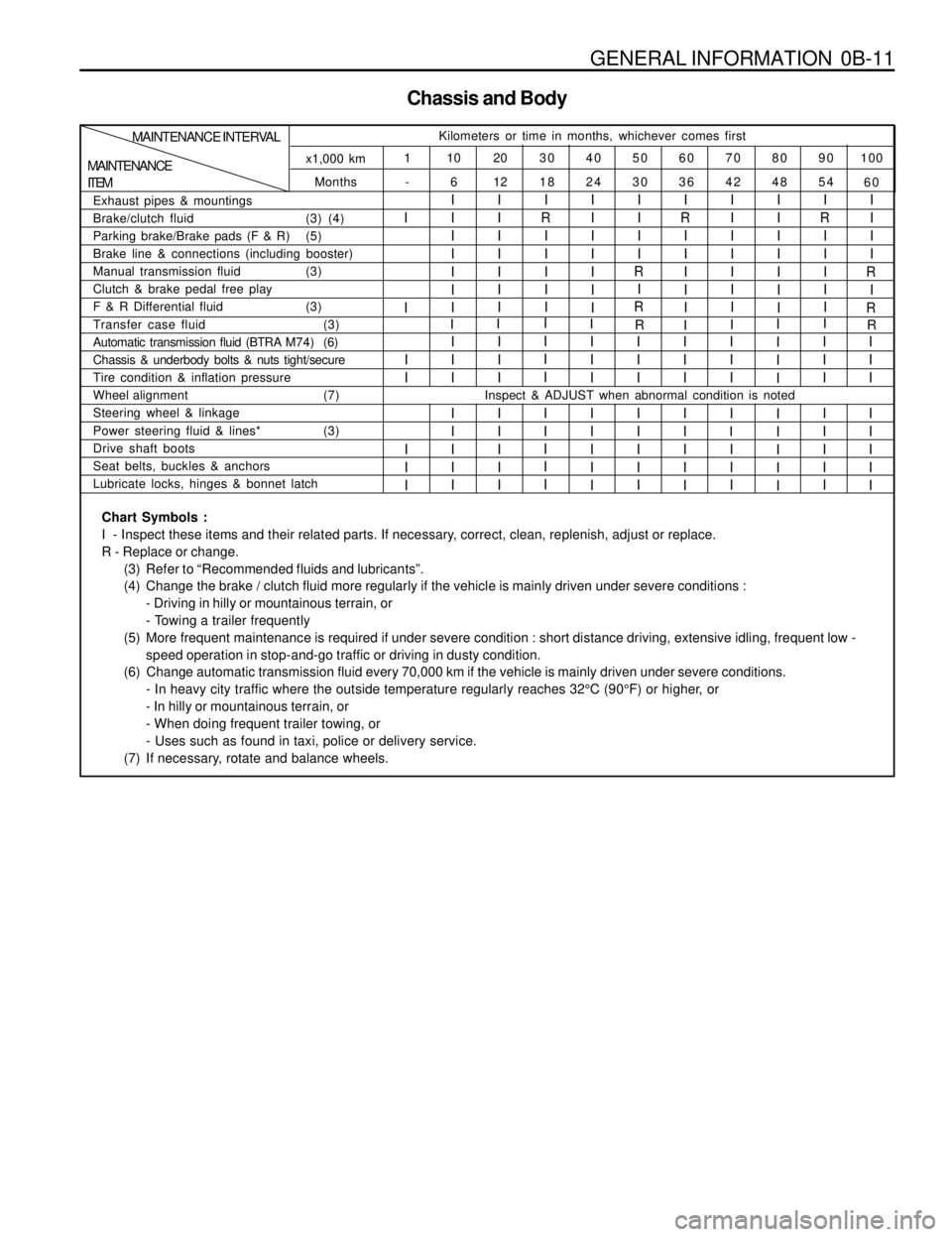change wheel SSANGYONG MUSSO 1998 Workshop Repair Manual
[x] Cancel search | Manufacturer: SSANGYONG, Model Year: 1998, Model line: MUSSO, Model: SSANGYONG MUSSO 1998Pages: 1463, PDF Size: 19.88 MB
Page 19 of 1463

GENERAL INFORMATION 0B-7
MAINTENANCE AND REPAIR
MAINTENANCE AND LUBRICATION
Fuel Filter Replacement
Replace the engine fuel filter every.
lGasoline Engine : 60,000km (36,000 miles)
lDiesel Engine : 45,000km (24,000 miles)
Spark Plug Replacement
Replace spark plugs with same type.
lType : BOSCH : F8DC4
BERU : 14F-8DU4
Champion : C11YCC
lGap : 0.8 ± 0.1 mm
Spark Plug Wire Replacement
Clean wires and inspect them for burns, cracks or other
damage. Check the wire boot fit at the Distributor and at
the spark plugs. Replace the wires as needed.
Brake System Service
Check the disc brake pads or the drum brake linings.
Check the pad and the lining thickness carefully.
Tire and Wheel Inspection and Rotation
Check the tires for abnormal wear or damage. To
equalize wear and obtain maximum tire life, rotate the
tires. If irregular or premature wear exists, check the
wheel alignment and check for damaged wheels. While
the tires and wheels are removed, inspect the brakes.
NORMAL VEHICLE USE
The maintenance instructions contained in the
maintenance schedule are based on the assumption
that the vehicle will be used for the following reasons:
lTo carry passengers and cargo within the limitation
of the tire inflation prassure. Refer to “Tire and Wheel”
in section 2E.
lTo be driven on reasonable road surfaces and within
legal operating limits.
EXPLANATION OF SCHEDULED
MAINTENANCE SERVICES
The services listed in the maintenance schedule are
further explained below. When the following maintenance
services are performed, make sure all the parts are
replaced and all the necessary repairs are done before
driving the vehicle. Always use the proper fluid and
lubricants.
Engine Oil and Oil Filter Change
Always use above the API SH grade or recommended
engine oil.
Engine Oil Viscosity
Engine oil viscosity (thickness) has an effect on fuel
economy and cold weather operation. Lower viscosity
engine oils can provide better fuel economy and cold
weather performance; however, higher temperature
weather conditions require higher viscosity engine oils
for satisfactory lubrication. Using oils of any viscosity
other than those viscosities recommended could result
in engine damage.
Cooling System Service
Drain, flush and refill the system with new coolant. Refer
to “Recommended Fluids And Lubricants” in this section.
Air Cleaner Element Replacement
Clean the air cleaner element every.
lGasoline Engine : 15,000km (10,000 miles)
lDiesel Engine : 10,000km (6,000 miles)
Replace the air cleaner element every .
lGasoline Engine : 60,000km (36,000 miles)
lDiesel Engine : 30,000km (18,000 miles)
Replace the air cleaner more often under dusty
conditions.
Tire Rotation (Left - Hand Drive Type)
Page 21 of 1463

GENERAL INFORMATION 0B-9
Chassis and Body
Months
MAINTENANCE
ITEMMAINTENANCE INTERVALKilometers or time in months, whichever comes first
120 105 90 75 60 45 30 15 1
96 84 72 60 48 36 24 12
- x1,000 km
Exhaust pipes & mountings
Brake/Clutch fluid(3)(4)
Parking brake/Brake pads F & R (5)
Brake line & connections (including booster)
Manual transmission oil (3)
Clutch & brake pedal free play
Front & Rear Differential Fluid (3)I
R
I
I
I
I
I-
-
-
I
I
-
II
I
I
I
I
I
II
R
I
I
I
I
II
I
I
I
R
I
RI
I
I
I
I
I
II
R
I
I
R
I
RI
I
I
I
I
I
II
R
I
I
I
I
I
Automatic transmission fluid (MB W4A040) (6)
Automatic transmission fluid (BTRA M74)
Chassis & underbody bolts & nuts tight/secure
Tire condition & inflation pressure
Wheel alignment (7)
Steering wheel & linkage
Power steering fluid & lines* (3)
Drive shaft boots
Seat belts, buckles & anchors
Lubricate locks, hinges & bonnet latchI
I
I
I
II
I
I
I
I
I
I
I
I
II
I
I
I
I
I
I
I
I
IR
I
I
I
I
I
I
I
II
I
I
I
I
I
I
I
II
I
I
I
I
I
I
I
I
IR
R
I
I
I
I
I
I
I
II
I
I
I
I
I
I
I
I
Transfer case fluidRIII
Inspect & ADJUST when abnormal condition is noted
I
I
I
I
I
I
I
I
I
Chart Symbols :
I - Inspect these items and their related parts. If necessary, correct, clean, replenish, adjust or replace.
R - Replace or change.
(3) Refer to “Recommended fluids and lubricants”.
(4) Change the brake / clutch fluid every 15,000 km if the vehicle is mainly driven under severe conditions:
- Driving in hilly or mountainous terrain, or
- Towing a trailer frequently
(5) More frequent maintenance is required if under severe condition : short distance driving, extensive idling, frequent low -
speed operation in stop-and-go traffic or driving in dusty condition.
(6) Change automatic transaxle fluid and filter every 75,000 km if the vehicle is mainly driven under severe conditions.
- In heavy city traffic where the outside temperature regularly reaches 32°C (90°F) or higher, or
- In hilly or mountainous terrain, or
- When doing frequent trailer towing, or
- Uses such as found in taxi, police or delivery service.
(7) If necessary, rotate and balance wheels.
Page 23 of 1463

GENERAL INFORMATION 0B-11
Chassis and Body
Months
-
MAINTENANCE
ITEMMAINTENANCE INTERVAL
Kilometers or time in months, whichever comes first
100 90 80 70 60 50 40 30 20 10 1
60 54 48 42 36 30 24 18 12 6 x1,000 km
Exhaust pipes & mountings
Brake/clutch fluid(3) (4)
Parking brake/Brake pads (F & R) (5)
Brake line & connections (including booster)
Manual transmission fluid (3)
Clutch & brake pedal free play
F & R Differential fluid (3)
I
II
I
I
I
I
I
II
I
I
I
I
I
II
R
I
I
I
I
II
I
I
I
I
I
II
I
I
I
R
I
RI
R
I
I
I
I
II
I
I
I
I
I
II
I
I
I
I
I
II
R
I
I
I
I
II
I
I
I
R
I
R
Automatic transmission fluid (BTRA M74) (6)
Chassis & underbody bolts & nuts tight/secure
Tire condition & inflation pressure
Wheel alignment (7)
Steering wheel & linkage
Power steering fluid & lines* (3)
Drive shaft boots
Seat belts, buckles & anchors
Lubricate locks, hinges & bonnet latchI
I
I
I
I
I
I
II
I
I
I
I
I
I
II
I
I
I
I
I
I
I
II
I
I
I
I
I
I
II
I
I
I
I
I
I
II
I
I
I
I
I
I
II
I
I
I
I
I
II
I
I
I
I
I
I
II
I
I
I
I
I
I
I
Transfer case fluid (3)R
IR
I II
I
I
I
I
II
I
I
I
I
I
I
I
I
Inspect & ADJUST when abnormal condition is noted
II
I
Chart Symbols :
I - Inspect these items and their related parts. If necessary, correct, clean, replenish, adjust or replace.
R - Replace or change.
(3) Refer to “Recommended fluids and lubricants”.
(4) Change the brake / clutch fluid more regularly if the vehicle is mainly driven under severe conditions :
- Driving in hilly or mountainous terrain, or
- Towing a trailer frequently
(5) More frequent maintenance is required if under severe condition : short distance driving, extensive idling, frequent low -
speed operation in stop-and-go traffic or driving in dusty condition.
(6) Change automatic transmission fluid every 70,000 km if the vehicle is mainly driven under severe conditions.
- In heavy city traffic where the outside temperature regularly reaches 32°C (90°F) or higher, or
- In hilly or mountainous terrain, or
- When doing frequent trailer towing, or
- Uses such as found in taxi, police or delivery service.
(7) If necessary, rotate and balance wheels.
Page 24 of 1463

0B-12 GENERAL INFORMATION
OWNER INSPECTIONS
AND SERVICES
WHILE OPERATING THE VEHICLE
Horn Operation
Blow the horn occasionally to make sure it works. Check
all the button locations.
Brake System Operation
Be alert for abnormal sounds, increased brake pedal
travel or repeated puling to one side when braking. Also,
if the brake warning light goes on, or flashes, something
may be wrong with part of the brake system.
Exhaust System Operation
Be alert to any changes in the sound of the system or
the smell of the fumes. These are signs that the system
may be leaking or overheating. Have the system
inspected and repaired immediately.
Tires, Wheels and Alignment Operation
Be alert to any vibration of the steering wheel or the
seats at normal highway speeds. This may mean a wheel
needs to be balanced. Also, a pull right or left on a
straight, level road may show the need for a tire pressure
adjustment or a wheel alignment.
Steering System Operation
Be alert to changes in the steering action. An inspection
is needed when the steering wheel is hard to turn or
has too much free play, or is unusual sounds are noticed
when turning or parking.
Headlight Aim
Take note of the light pattern occasionally. Adjust the
headlights if the beams seem improperly aimed.
AT EACH FUEL FILL
A fluid loss in any (except windshield washer) system
may indicate a problem. Have the system inspected and
repaired immediately.
Engine Oil Level
Check the oil level and add oil if necessary. The best
time to check the engine oil level is when the oil is warm.
1. After stopping the engine, wait a few minutes for the
oil to drain back to the oil pan.
2. Pull out the oil level indicator (dip stick).
3. Wipe it clean, and push the oil level indicator back
down all the way.
4. Pull out the oil level indicator and look at the oil level
on it.5. Add oil, if needed, to keep the oil level above the
lower mark. Avoid overfilling the engine, since this
may cause engine damage.
6. Push the indicator all the way back down into the
engine after taking the reading.
If you check the oil level when the oil is cold, do not run
the engine first. The cold oil will not drain back to the
pan fast enough to give a true oil level reading.
Engine Coolant Level and Condition
Check the coolant level in the coolant reservoir tank
and add coolant if necessary. Inspect the coolant.
Replace dirty or rusty coolant.
Windshield Washer Fluid Level
Check the washer fluid level in the reservoir. Add fluid if
necessary.
AT LEAST TWICE A MONTH
Tire And Wheel Inspection and Pressure
Check
Check the tire for abnormal wear or damage. Also check
for damaged wheels. Check the tire pressure when the
tires are cold ( check the spare also, unless it is a
stowaway). Maintain the recommended pressures. Refer
to “Tire and Wheel” is in section 0B.
AT LEAST MONTHLY
Light Operation
Check the operation of the license plate light, the
headlights (including the high beams), the parking lights,
the fog lights, the taillight, the brake lights, the turn
signals, the backup lights and the hazard warning flasher.
Fluid Leak Check
Periodically inspect the surface beneath the vehicle for
water, oil, fuel or other fluids, after the vehicle has been
parked for a while. Water dripping from the air
conditioning system after use is normal. If you notice
fuel leaks or fumes, find the cause and correct it at once.
AT LEAST TWICE A YEAR
Power Steering System Reservoir Level
Check the power steering fluid level. Keep the power
steering fluid at the proper level. Refer to
Section 6A,
Power Steering System.
Brake Master Cylinder Reservoir Level
Check the fluid and keep it at the proper level. A low
fluid level can indicate worn disc brake pads which may
need to be serviced. Check the breather hole in the
reservoir cover to be free from dirt and check for an
open passage.
Page 25 of 1463

GENERAL INFORMATION 0B-13
Weather-Strip Lubrication
Apply a thin film silicone grease using a clean cloth.
EACH TIME THE OIL IS CHANGED
Brake System Inspection
This inspection should be done when the wheels are
removed for rotation. Inspect the lines and the hoses
for proper hookup, binding, leaks, cracks, chafing, etc.
Inspect the disc brake pads for wear. Inspect the rotors
for surface condition. Inspect other brake parts, the
parking brake, etc., at the same time. Inspect the brakes
more often if habit or conditions result in frequent braking.
Steering, Suspension and Front Drive Axle
Boot And Seal Inspection
Inspect the front and rear suspension and the steering
system for damaged, loose or missing parts, signs of
wear or lack of lubrication. Inspect the power steering
line and the hoses for proper hookup, binding, leaks,
cracks, chafing, etc. Clean and inspect the drive axle
boot and seals for damage, tears or leakage. Replace
the seals if necessary.
Exhaust System Inspection
Inspect the complete system (including the catalytic
converter if equipped). Inspect the body near the exhaust
system. Look for broken, damaged, missing, or out-of-
position parts as well as open seams, holes, loose
connections, or other conditions which could cause heat
buildup in the floor pan or could let exhaust fumes seep
into the trunk or passenger compartment.
Throttle Linkage Inspection
Inspect the throttle linkage for interference or binding,
damaged, or missing parts. Lubricate all linkage joints
and throttle cable joints, the intermediate throttle shaft
bearing, the return spring at throttle valve assembly, and
the accelerator pedal sliding face with suitable grease.
Check the throttle cable for free movements.
Engine Drive Belts
Inspect all belts for cracks, fraying, wear and proper
tension. Adjust or replace the belts as needed.
Hood Latch Operation
When opening the hood, note the operation of the
secondary latch. It should keep the hood from opening
all the way when the primary latch is released. The hood
must close firmly.
AT LEAST ANNUALLY
Lap and Shoulder Belts Condition and
Operation
Inspect the belt system including: the webbing, the
buckles, the latch plates, the retractor, the guide loops
and the anchors.
Movable Head Restraint Operation
On vehicles with movable head restraints, the restraints
must stay in the desired position.
Spare Tire and Jack Storage
Be alert to rattles in the rear of the vehicle. The spare
tire, all the jacking equipment, and the tools must be
securely stowed at all times. Oil the jack ratchet or the
screw mechanism after each use.
Key Lock Service
Lubricate the key lock cylinder.
Body Lubrication Service
Lubricate all the body door hinges including the hood,
the fuel door, the rear compartment hinges and the
latches, the glove box and the console doors, and any
folding seat hardware.
Underbody Flushing
Flushing the underbody will remove any corrosive
materials used for ice and snow removal and dust control.
At least every spring clean the underbody. First, loosen
the sediment packed in closed areas of the vehicle. Then
flush the underbody with plain water.
Engine Cooling System
Inspect the coolant and freeze protection fluid. If the fluid
is dirty or rusty, drain, flush and refill the engine cooling
system with new coolant. Keep the coolant at the proper
mixture in order to ensure proper freeze protection,
corrosion protection and engine operating temperature.
Inspect the hoses. Replace the cracked, swollen, or
deteriorated hoses. Tighten the clamps. Clean the
outside of the radiator and the air conditioning
condenser. Wash the filler cap and the neck. Pressure
test the cooling system and the cap in order to help
ensure proper operation.
Page 830 of 1463

2B-2 WHEEL ALIGNMENT
DIAGNOSIS
TIRE DIAGNOSIS
Irregular and Premature Wear
Irregular and premature tire wear has many causes.
Some of them are incorrect inflation pressures, lack of
regular rotation, poor driving habits, or improper wheel
alignment.
Rotate the tires if :
lThe front tire wear is different from the rear.
lThe left and right front tire wear is unequal.
lThe left and right rear tire wear is unequal, Check
wheel alignment if :
lThe left and right front tire wear is unequal.
lThe wear is uneven across the tread of either front
tire.
lThe front tire treads are scuffed with “feather” edges
on the side of the tread ribs or blocks.
Tread Wear Indicators
The original equipment tires have built-in tread wear
indicators to show when the tires need replacement.
These indicators appear as bands when the tire tread
depth becomes shallow. Tire replacement is
recommended when the indicators appear in three or
more grooves at six locations.
Radial Tire Waddle
Waddle is side-to-side movement at the front or rear of
the vehicle. It is caused by the steel belt not being straight
within the tire, or by excessive lateral runout of the tire
or wheel.
The vehicle must be road tested to determine which end
of the vehicle has the faulty tire. The rear end of the
vehicle will shake from side to side or “waddle” if the
waddle tire is on the rear of the vehicle. From the driver’s
seat, it feels as though someone is pushing on the side
of the vehicle. If the faulty tire is on the front of the vehicle,
the waddle is more visual. The front sheet meld appears
to be moving back and forth, and the drivers seat feels
like the pivot point in the vehicle.
Waddle can be diagnosed using the method of
substituting known good tire and wheel assemblies on
the problem vehicle
1. Road test the vehicle to determine if the waddle is
coming from the front or the rear of the vehicle.
2. Install good tires and wheels from a similar vehicle in
place of those on the offending end of the problem
vehicle. If the source of the waddle is not obvious,
change the rear tires.
Page 835 of 1463

WHEEL ALIGNMENT 2B-7
Camber
1. Remove the free wheel hub.
2. Measure camber with a wheel alignment equipment.
3. If camber measurements are not within specification, adjust
it by increasing or decreasing the number of adjusting shims
(1) inserted between the upper arm shaft and cross bracket.
Camber Change
Notice
Difference between the left and right should be adjusted
within 30’.
Specification0°±30’
Caster
1. Remove the free wheel hub.
2. Measure caster with a wheel alignment equipment and a
turning radius gauge.
Specification2° 30’ ± 30’
Adjusting Shims
1.6 Iarge
3.2 largeIncreasing 1 ea
+ 19’
+ 38’Decreasing 1 ea
- 19’
- 38’
Page 836 of 1463

2B-8 WHEEL ALIGNMENT
Increasing 1ea
- 11’
- 43’
3. If caster measurements are not within specification, adjust
it by increasing 1ea (rear) or decreasing 1ea (front).
Caster Change
Notice
Difference between the left and right should be adjusted
within 30’.
0.4 small
1.6 small
Decreasing 1ea
+ 11’
+ 43’
FRONT
Adjusting Shims
Increasing 1ea
+ 11’
+ 43’ 0.4 small
1.6 small
Decreasing 1ea
- 11’
- 43’
REAR
Adjusting Shims
Page 942 of 1463

4D-4 FRONT DISC BRAKES
5. Pull out the brake pads. Replace pads if necessary.
Notice
Always change the all pads on one wheel at a time.
6. Installation should follow the removal procedure in the
reverse order.
7. Bleed the air from the system.
Page 943 of 1463

FRONT DISC BRAKES 4D-5
4. Measure rotor disc thickness.
UNIT REPAIR
FRONT DISC BRAKE
Inspection Procedure
1. Clean all components and visually check the followings.
lCheck the cylinder and piston for wear, rust or damage.
lCheck the caliper body and guide pin for wear, damage
or crank.
lCheck the pads for uneven wear or oiliness.
lCheck the boots for damage or tear.
2. Measure caliper housing inner diameter.
Item
With PBR
With MANDOWear Limit
f 61.4 mm
f 61.0 mm
Standard
10 mmWear Limit
2.0 mm
Standard
f 60.4 mm
f 60.0 mm
3. Measure pad thickness.
Notice
Always change the all pads on one wheel at a time.
5. Check the rotor disc for score or runout.
Standard
24 mmWear Limit
22 mm